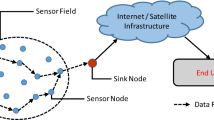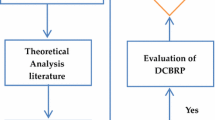Abstract
Wireless sensor networks (WSNs) are an emerging technology for monitoring physical world. Different from the traditional wireless networks and ad hoc networks, the energy constraint of WSNs makes energy saving become the most important goal of various routing algorithms. For this purpose, a cluster based routing algorithm LEACH (low energy adaptive clustering hierarchy) has been proposed to organize a sensor network into a set of clusters so that the energy consumption can be evenly distributed among all the sensor nodes. Periodical cluster head voting in LEACH, however, consumes non-negligible energy and other resources. While another chain-based algorithm PEGASIS (power- efficient gathering in sensor information systems) can reduce such energy consumption, it causes a longer delay for data transmission. In this paper, we propose a routing algorithm called CCM (Chain-Cluster based Mixed routing), which makes full use of the advantages of LEACH and PEGASIS, and provide improved performance. It divides a WSN into a few chains and runs in two stages. In the first stage, sensor nodes in each chain transmit data to their own chain head node in parallel, using an improved chain routing protocol. In the second stage, all chain head nodes group as a cluster in a self- organized manner, where they transmit fused data to a voted cluster head using the cluster based routing. Experimental results demonstrate that our CCM algorithm outperforms both LEACH and PEGASIS in terms of the product of consumed energy and delay, weighting the overall performance of both energy consumption and transmission delay.
Similar content being viewed by others
References
Akyildiz I. F., Su W., Sankarasubramaniam Y., Cayirci E. (2002) A survey on sensor networks. IEEE Communications Magazine 40(8): 102–114
Al-Karaki J. N., Kamal A. E. (2004) Routing techniques in wireless sensor networks: A Survey. IEEE Wireless Communications 11(6): 6–28
Braginsky, D., & Estrin, D. (2002). Rumor routing algorithm for sensor networks. In Proceedings of the Eighth ACM International Conference on Mobile Computing and Networking (MobiCom 2002) (pp.22–31), Sep 23–28, 2002, Georgia, USA.
Chao H. Y., Chen Y. Q., Ren W. (2006) A study of grouping effect on mobile actuator sensor networks for distributed feedback control of diffusion process using central voronoi tessellations. International Journal of Intelligent Control and Systems 11(2): 185–190
Heinzelman, W.R., Chandrakasan, A., & Balakrishnan, H. (2000). LEACH: Energy-efficient communication protocol for wireless microsensor networks. In Proceedings of Hawaii International Conference on System sciences (pp. 3005–3014), 4–7 Jan, 2000, Maui, Hawaii.
Heinzelman, W. R., Kulik, J., & Balakrishnan H. (1999). Adaptive protocols for information dissemination in wireless sensor networks. In Proceedings of the 5thACM International Conference on Mobile Computing and Networking(MobiCom 99) (pp. 174–185), 15–20 Aug, 1999, Seattle, WA, USA.
Intanagonwiwat, C., Govindan, R., & Estrin, D. (2000). Directed Diffusion: A scalable and roubst communication paradigm for sensor networks. In Proceedings of the Eighth ACM International Conference on Mobile Computing and Networking (MobiCom 2002) (pp. 56–67), Sep 23–28, 2002, Georgia, USA.
Karlof, C. Li, Y., & Polastre, J. (2003). ARRIVE: An architecture for robust routing in volatile environments. University of California at Berkeley, Technical report UCB-CSD-03-1233.
Kulik J., Heinzelman W. R., Balakrishnan H. (2002) Negotiation-based protocols for disseminating information in wireless sensor networks. Wireless Networks 8(2): 169–185
Lindsey, S., & Raghavendra, C. (2002). PEGASIS: Power-efficient gathering in sensor information systems. In Proceedings of IEEE Aerospace Conference, Vol. 3 (pp. 1125–1130), March 2002.
Lindsey, S., Raghavendra C. S., & Sivalingam K. (2001). Data gathering in sensor networks using the energy*delay metric. In Proceedings of the IPDPS Workshop on Issues in Wireless Networks and Mobile Computing (p. 188), Apr 23–27, 2001, San Francisco, USA
Manjeshwar, A., & Agrawal, D. P. (2001). TEEN: A routing protocol for enhanced efficiency in wireless sensor networks. In Proceedings of the 15th Parallel and Distributed Processing Symposium (IPDPS-01) (pp. 2009–2015), Apr 23–27, 2001, San Francisco, USA.
Ming Y. U., Aniket M., Wei S. U. (2005) An environment monitoring system architecture based on sensor networks. International Journal of Intelligent Control and Systems 10(3): 201–209
Ramanathan, R., & Hain, R. (2000). Topology control of multihop wireless networks using transmit power adjustment. In Proceedings Infocom 2000 (pp. 404–413), March 26–30, 2000, Tel-Aviv, Israel.
Ye, F., Chen, A., Liu, S., & Zhang, L. (2001). A scalable solution to minimum cost forwarding in large sensor networks. In Proceedings of the tenth International Conference on Computer Communications and Networks (ICCCN 2001) (pp. 304–309), July 7–14, 2001, Vancouver, British Columbia, Canada.
Younis O., Fahmy S. (2004) HEED: A Hybrid, Energy-Efficient, Distributed Clustering Approach for Ad Hoc Sensor Networks. IEEE Transactions on Mobile Computing 3(4): 366–379
Author information
Authors and Affiliations
Corresponding author
Rights and permissions
About this article
Cite this article
Tang, F., You, I., Guo, S. et al. A chain-cluster based routing algorithm for wireless sensor networks. J Intell Manuf 23, 1305–1313 (2012). https://doi.org/10.1007/s10845-010-0413-4
Received:
Accepted:
Published:
Issue Date:
DOI: https://doi.org/10.1007/s10845-010-0413-4




